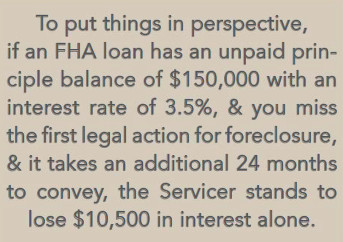Servicing FHA Loans continues to be challenging and, in many instances, includes high losses on default liquidated loans. While FHA delinquencies have greatly improved compared to post crisis delinquency, there are still over 7.8 million outstanding FHA insured loans with delinquency rates that rose as high as 11.25 percent according to the FHA Single Family Loan Performance Trends report published by HUD this past January.
When working with FHA Loans in default, there are many key time frames that must be met in order to minimize losses, beginning as soon as the date the loan was last contractually current, and continuing throughout the claim filing process. In many cases just missing the start of a foreclosure action by one day can result in increased losses of thousands of dollars. Failure to meet all time frames will not only result in interest curtailments, but ultimately the curtailment of advances as well. These losses can be further exacerbated depending on the type of pool, the Servicer’s ability to limit interest rate spreads, and time required to resolve. Additionally, if there was a missed time frame, FHA will only pay debenture interest to the point of the interest curtailment. After the interest curtailment, HUD will no longer pay debenture interest on the Unpaid Principle Balance.
To put things in perspective, if an FHA loan has an Unpaid Principle Balance of $150,000 with an interest rate of 3.5 percent, and you miss the first legal action for foreclosure, and it takes an additional 24 months to convey, the Servicer stands to lose $10,500 in interest alone. In addition to interest curtailments, the Servicer must fully comply with the allowable fee schedule for all legal actions and property preservation expenses. Overhead costs as well as any fees or costs associated with clearing title issues are not reimbursable or recoverable through a claim to HUD.
 FHA rules change frequently with the possibility of multiple sets of rules applying to one loan. One of the biggest challenges of servicing FHA delinquent loans is the conveyance of the property to HUD within the HUD time frames. To meet HUD Conveyance time frames, HUD requires properties to be conveyed within 30 days of the greater marketable title and possession. The definition of marketable title is the recorded foreclosure deed; the definition of possession is the date the property became vacant or should have known to be vacant. While conveying to HUD within 30 days of these dates is realistic, the unrealistic portion of the requirements is also obtaining clear and marketable title, ensuring all taxes are paid current, obtaining all condo/HOA and utility invoices, along with having these paid current, before conveying the property to HUD within that 30-day period. While Servicers struggle to address all of these conveyance requirements, the property sits vacant, in some cases becomes vandalized, which creates a liability not only to the servicer but also to the community and neighborhood as well.
FHA rules change frequently with the possibility of multiple sets of rules applying to one loan. One of the biggest challenges of servicing FHA delinquent loans is the conveyance of the property to HUD within the HUD time frames. To meet HUD Conveyance time frames, HUD requires properties to be conveyed within 30 days of the greater marketable title and possession. The definition of marketable title is the recorded foreclosure deed; the definition of possession is the date the property became vacant or should have known to be vacant. While conveying to HUD within 30 days of these dates is realistic, the unrealistic portion of the requirements is also obtaining clear and marketable title, ensuring all taxes are paid current, obtaining all condo/HOA and utility invoices, along with having these paid current, before conveying the property to HUD within that 30-day period. While Servicers struggle to address all of these conveyance requirements, the property sits vacant, in some cases becomes vandalized, which creates a liability not only to the servicer but also to the community and neighborhood as well.
FHA has taken great measures to reduce the number of conveyed properties by improving the CWCOT (Claims Without Conveyance of Title) Claims Process. Towards the end of 2014, HUD released a communication, ML 2014-24, which enhanced the entire CWCOT program. With this communication, it required all servicers to begin utilizing a CAFMV (Commissioners Adjusted Fair Market Value) bidding process that encourages more competitive bidding at the foreclosure sale, which allowed for an increase in the amount of sales to third parties as opposed to the Servicers. As a result of these changes, the number of conveyances has been reduced and is less today than it was before the default crisis. The CWCOT program has been a value-add to the industry with reduced losses and out-of-pocket expenses post foreclosure sale.
There is no doubt that high default volumes and constant regulatory changes have made meeting all time frames and guidelines a challenge. Hiring experienced staff, and having appropriate systems to manage the complex business rules is an industry challenge. In an effort to minimize losses and improve recoveries, one must analyze the losses and identify responsible parties.
Once this has been completed, meaningful conversations can occur and process improvements can begin by assigning accountability as well as responsibility for corrective actions to take place. Communication to internal business partners and external third-party providers is critical for the success of the improvements.
After communicating losses to the responsible parties, as well as engaging them in solutions and assigning accountability, the losses will decrease. Managing expectations with effective collaboration is a daily requirement. Making improvements and executing on them is a great deal of work requiring tremendous discipline from all participants. The good news is we are starting to see the improvements take place, and as a result, losses are decreasing by thousands of dollars per loan.
It is always imperative to understand where your losses come from, how they can be avoided and then putting necessary controls in place to ensure you are avoiding them. Leveraging third-party vendors to assist in this process may expedite the review of analysis of losses and providing feedback for process improvements. Each Servicer has the ability to view losses at a high level or utilize experienced vendors to complete a forensic review. This decision all depends on each Servicer and the amount of losses they are willing to take. One thing is certain: the sooner you get started, the sooner the losses will decrease. After all, mistakes and errors are simply too expensive.
Thank you,
Jodi Gaines
Executive Board Member
Reditus Investor Services, LLC

 Login
Login

